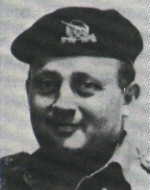Son of Manos HaKohen and Reizel. He was born on July 1, 1924 in Kremenets, Poland. He studied at the Tarbut elementary school and high school until the city was occupied by the Russians in 1939. With the opening of Technikom for mechanics and forestry in his hometown, he began studying there until the outbreak of the war between Germany and the Soviet Union in 1941. When the Germans approached Krzemieniec Was sent by his parents to relatives who lived near Cube, so that their eldest son would be saved from the Nazis, and he continued his studies until 1942, when he was 18 years old, conscripted into the Red Army, and was the only Jew among the Russians in his unit. His four years of service in the Red Army gave him a first experience in leading combat soldiers and successfully completed professional courses In 1946 he was drafted into the Haganah and completed the first commanding course of the Haganah. The Haganah, and later was appointed to senior positions, such as the management of DP camps and the “escape” and “Hagana” points in Germany and Austria, and he was responsible for the camps in Frankfurt and Kassel, Germany. For the future. In February 1948, at the height of the War of Independence, he arrived in Israel in the framework of Gahal (Overseas Recruitment), and was received warmly and warmly by his uncle and aunt in Merhavia, where he began to build his home and establish his family. Military experience and knowledge acquired by the Red Army, joined the Golani Brigade and participated in battles in the Galilee and the Negev as platoon commander and commander After finishing the War of Independence he was again sent to an officers’ course and began to engage in anti-aircraft fire, A battalion commander. From 1963-1966 he served as an anti-aircraft artillery officer in the IDF. During his years of service in the Israel Defense Forces, he completed all the senior courses, including the Command and Staff School, and reached the rank of lieutenant colonel, and was preparing to be admitted to the Technion. , About a year before the Six-Day War, at the beginning of November 1968, the President of the State, Mr. Zalman Shazar, awarded him the medal of the State Medal. One of the most difficult and responsible positions he spent during his years in the army was the absorption of young soldiers into the IDF, which he saw as a great challenge because he was able to shape the image of the young soldier for the difficult trials he would have to face. He devoted his energies and soul to the soldiers and saw them as the fruits of his labors and often told of the great satisfaction he saw in his work. “Motke” called him everything, because he had a “gold Lev” and a good smile was He did not flinch from giving help to others, but his demands were firm But he always demanded of himself no less, and sometimes even more, his house was a warm and open house, and everyone was welcome, and he was devoted to his wife and a loving father to his children, whom he raised and educated to the love of the people and the homeland. His enthusiasm and identification with every subject he dealt with, and that was the result of the assessment of his commanders, his desire to buy an opinion was not fulfilled, but it was satisfied with his self-study, training and tours abroad.Difficult, which in her pain struggled until his dying day. On Tuesday, 15 October, 1969, he died of his illness and laid down a wife and three children, who was brought to rest in the military cemetery in Kiryat Shaul, in a letter of condolences to his wife. leaving the foundations of the artillery corps in general and of anti-aircraft defense in particular. He saw the development and glorification of the corps to which he had devoted so much, that apart from his love for his family and his home, he reserved a place for love for the army and its soldiers. So his commanders, subordinates and friends liked him. On his way to the IDF, he was a partner in three wars and served in command and headquarters, and all of them were filled with unlimited dedication and excellent professional knowledge and with full success, and his memory and work will not be forgotten by the hearts of those who recognized and cherished him. ” Members of the Hagana organization in Europe and North Africa recorded it in the “Golden Book” of the Jewish National Fund on the day of the “Thirty” In April 1970, the members of his town drew up a picture of him and remembered him in a booklet entitled “The Voice of Kremenets in Israel and the Diaspora”; A Torah scroll in his memory was brought by the family to the Moreshet Avot Synagogue in Neve Magen; His many friends founded a scholarship fund in his memory, from which grants are awarded to students of the high school in Ramat Hasharon, on essays related to the history of Israel, the Haganah and the Haganah.
